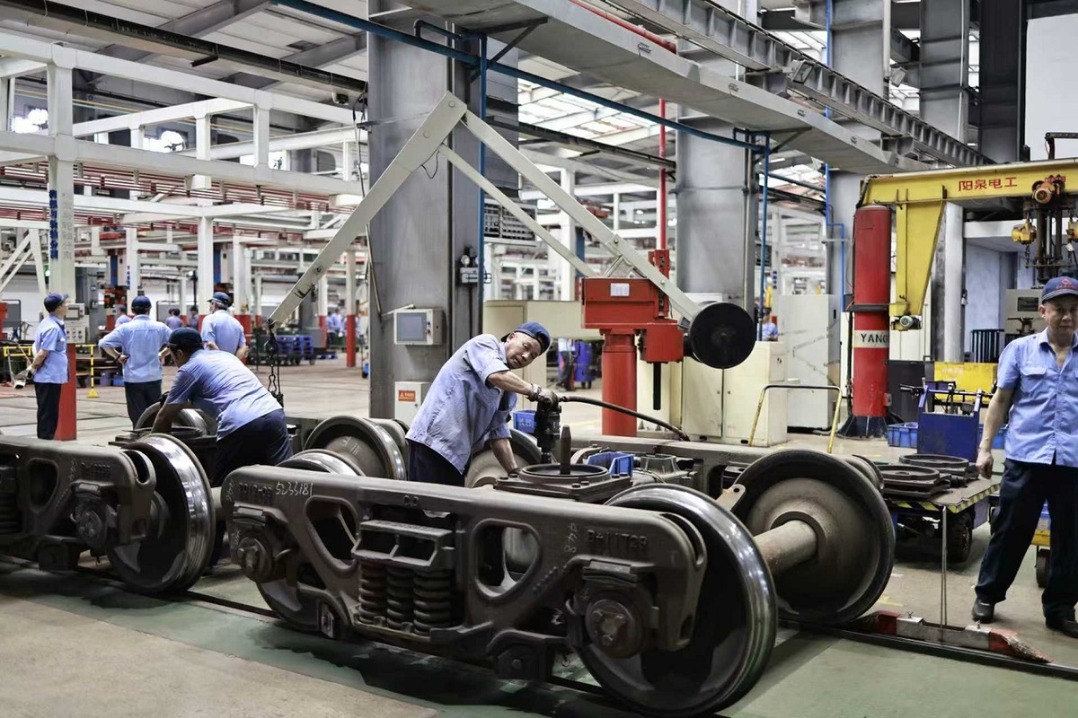Pioneer city comes of age


Shenzhen's extraordinary journey from a fishing village to one of the world's great technology hubs is nothing short of a miracle. As the city marks its 45th anniversary as one of the nation's first special economic zones, Zhou Mo traces the rise of this 'economic miracle' that has changed the lives of generations of workers from across the country.
Walking along the 25-kilometer-long Shennan Boulevard - one of Shenzhen's major arterial thoroughfares - takes Wang Guofu down memory lane. With the cityscape unfolding before him, he reminisces about its remarkable transformation, recalling how his fate has been intertwined with the metropolis in its 45-year-long history as one of China's pioneering special economic zones (SEZs).
The 58-year-old factory worker left his hometown in Shangrao — a city in eastern Jiangxi province — in search of greener pastures in Shenzhen in 1992 following in the footsteps of an adventurous friend.
"I knew next to nothing about Shenzhen at the time," says Wang. "All I knew was that it's near Hong Kong and that, as my friend put it, Shenzhen was a place to seek a fortune."
After setting foot in the southern town in Guangdong province, he realized it was far more than that. "In Shenzhen, everyone worked with energy and drive. It was like they were building their homes," he says.
Shenzhen's inherent spirit of entrepreneurship and inclusiveness emboldened Wang's resolve to bring his family and settle down there. Today, his daughter works at a financial technology firm in the city. "I'm fortunate that my family has been able to grow up together with Shenzhen," he says.
Wang's story is woven into the tapestry of tens of thousands of workers who have contributed to Shenzhen's early development as one of the country's first four SEZs, and whose second generation has moved on to sink their roots into the city, continuing to contribute to its growth.
The vast opportunities Shenzhen has created for generations of Chinese residents mirror the boomtown's dramatic industrial evolution and shifting identity over time. In the 1980s and early 1990s, manufacturing, construction and trade were the lifeblood of Shenzhen's economy. Leveraging its proximity to Hong Kong, along with low land and labor costs, Shenzhen thrived on processing trade - a model that propelled rapid growth, but left it lingering at the lower end of the global value chain, with local workers reaping only a small share of the gains.
According to official statistics, the value of processing trade in Shenzhen accounted for roughly 72 percent of the city's total export value and 76 percent of total import value in 1990. The number of processing trade-related enterprises surged to almost 8,000 in 1994, with some 1 million people employed in the sector, including Wang.
Today, the land of opportunity has grown hand in hand with Shenzhen's meteoric rise as a hub for finance, technology and innovation. It is home to over 25,000 national-level high-tech enterprises, including tech giants Huawei, Tencent and DJI. The number of international patent applications made through the Patent Cooperation Treaty in Shenzhen has topped Chinese mainland cities for 21 consecutive years.
The transformation reflects a broader trend in Shenzhen, where emphasis has shifted from labor-intensive industries to knowledge-driven sectors. The evolution has also redefined the SEZ's identity, shifting it from the "world's factory" to a "cradle of innovation".
Like many other people of her age, the younger Wang found her footing in the new ecosystem. "The older generation was chasing fortune. We, the younger generation, are chasing something bigger — changing the way people live, just like Shenzhen has changed ours," she says.
City of opportunities
Shi Kun, director of the department of regional development and planning at Shenzhen-based think tank the China Development Institute, says, "When it comes to Shenzhen providing development opportunities for workers of different eras, the greatest chance lies in industrial opportunities. In other words, workers who come to Shenzhen can find jobs and earn money - this is the most fundamental aspect, which requires the development of industries that keep pace with the times.
"Beyond this, Shenzhen now also places great emphasis on supporting facilities, particularly comprehensive cultural, educational and healthcare support for knowledge-intensive talents," he adds.
There is also a fundamental urban culture in the city that underpins the provision of opportunities for workers, according to Shi. "Shenzhen has a well-known saying: 'Once you come, you are a Shenzhen local.' This saying actually embodies the positive cycle of mutual success between the city and individuals," he says.
Since Shenzhen's birth as an SEZ in 1980, its name has been synonymous with "economic miracle", with its GDP having skyrocketed from 270 million yuan ($37.58 million) in 1980 to 3.68 trillion yuan last year, roughly equivalent to the economic size of the United Arab Emirates.
Behind Shenzhen's economic boom lies its bold drive for institutional innovation. As a trailblazer of China's reform and opening-up, the city has blazed an unprecedented path — one that offers a replicable template for the rest of the nation.
Shenzhen's astonishing shift from a tiny fishing village to a world technology hub in the past four-and-a-half decades testifies to China's landmark reform and opening-up drive, shaped by domestic imperatives, as well as international opportunities, says Tao Yitao, former director of the China Center for Special Economic Zone Research at Shenzhen University.
She recalls that the mainland's economy was still budding in the late 1970s, with a broad consensus for change, and Shenzhen became a testing ground for bold experiments.
Internationally, the 1970s saw global industrial transfer, with labor-intensive industries moving from Japan and Germany to the "Four Asian Tigers" — South Korea, Singapore, Hong Kong and Taiwan. Shenzhen, leveraging its geographical proximity to Hong Kong and low labor and land costs, was a prime beneficiary. The establishment of Sino-US diplomatic ties in 1979 created a more favorable international environment for its development, says Tao, who is also dean of the Belt and Road Research Institute (Shenzhen) for International Cooperation and Development.
"Although Shenzhen's economic takeoff began with processing trade, it didn't end up there. By the 1990s, the local authorities had recognized the limitations of low-end manufacturing and decided to pivot its economy toward high-tech, laying a solid ground for its current tech hub status," she says.
Creating new miracle
To push Shenzhen toward assuming a greater role in the nation's pursuit of high-quality development and deeper integration into the world economy, the central government issued a document in June to further deepen comprehensive reform and accelerate opening-up and innovation.
The guideline outlined concrete steps to break through institutional barriers in education, technology and talent development, and strengthen the deep integration of innovation, industrial, capital and talent chains.
It also serves as an updated version of a directive in 2020 that focused on supporting Shenzhen as a pilot area for implementing comprehensive reform.
"The latest document has entrusted Shenzhen with new tasks and missions to advance reform, opening-up and innovative development at a higher starting point, on a higher level and with higher goals," wrote a group of researchers at the China Development Institute.
However, it has not been smooth sailing against a backdrop of mounting geopolitical tensions, rising protectionism and unilateralism.
"China-US trade frictions and global economic uncertainties pose serious challenges to Shenzhen's economy, including mounting trade barriers, supply chain disruptions and tech restrictions. To offset the impact, the city needs to accelerate industrial upgrading, explore emerging markets engaged in the Belt and Road Initiative, and boost research and development to achieve tech self-reliance," says Tao.

Shenzhen is pulling out all the stops to develop strategic emerging businesses and future industries as the answer to forging another "economic miracle" in the coming decades amid a volatile global landscape. It has launched policies to develop and bolster 20 strategic emerging sectors and nurture eight industries of the future.
The strategic emerging sectors cover telecommunications, semiconductors, intelligent terminals and sensors, software, intelligent robots, precision instruments and equipment, new energy, intelligent connected vehicles, new materials, high-end medical equipment and biomedicine.
Future industries will embrace synthetic biology, blockchain, cells and genes, space technology, brain science and brain-like intelligence, and quantum information.
"With continued focus on technological innovation, Shenzhen is poised to take the lead in emerging sectors such as artificial intelligence, big data, new energy and biotechnology. Through deeper collaboration with Hong Kong, Shenzhen will work hand in glove with the special administrative region to become a global financial hub," says Tao.
Shi considers "innovation and globalization" as the two keywords defining Shenzhen's next 45 years.
"Shenzhen has basically achieved the status where people immediately associate it with sci-tech innovation when the city is mentioned. In the future, it can further strengthen and elevate this advantage to make it more prominent," he says.
"As for globalization, it represents Shenzhen's ability to gather global elements such as talent, goods and data. Moving forward, Shenzhen is poised to develop into a globalized international metropolis."
For the younger Wang, however, what drew her most to work and live in Shenzhen was not just its promising industry outlook but, more importantly, the profound sense of belonging the city fosters.
"Shenzhen isn't just a place of opportunity. It's where I call home," she says.
Contact the writer at sally@chinadailyhk.com





































